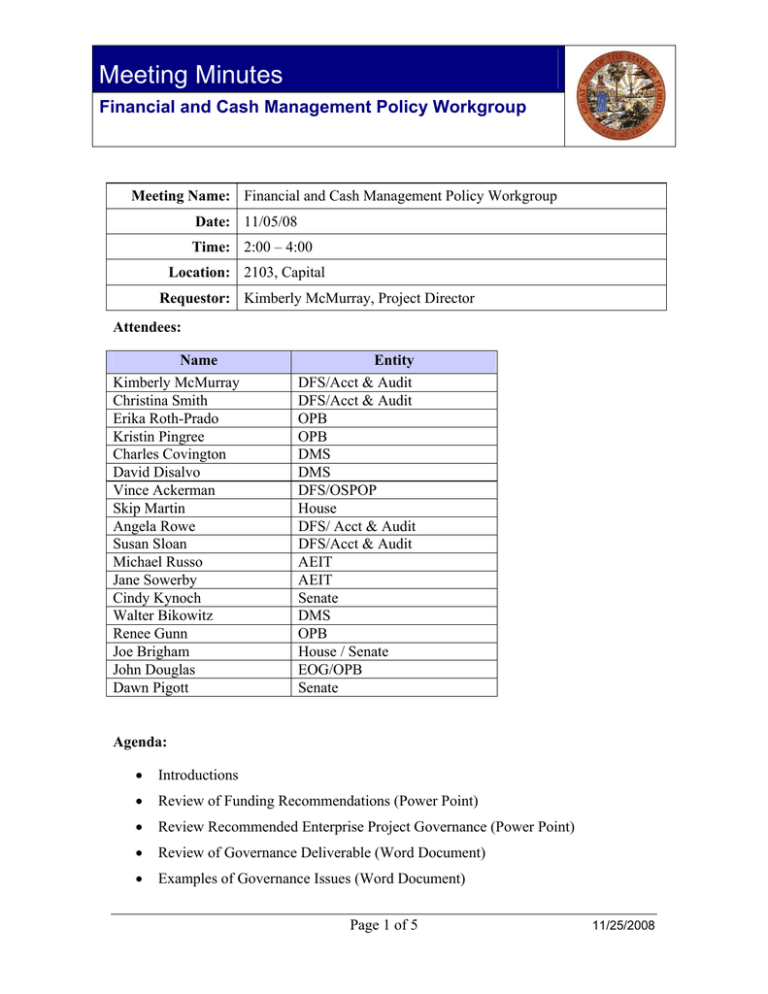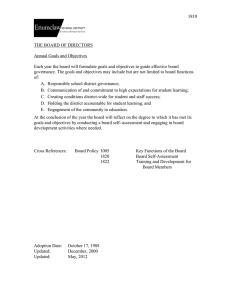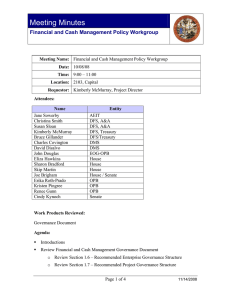Meeting Minutes Financial and Cash Management Policy Workgroup
advertisement

Meeting Minutes Financial and Cash Management Policy Workgroup Meeting Name: Financial and Cash Management Policy Workgroup Date: 11/05/08 Time: 2:00 – 4:00 Location: 2103, Capital Requestor: Kimberly McMurray, Project Director Attendees: Name Kimberly McMurray Christina Smith Erika Roth-Prado Kristin Pingree Charles Covington David Disalvo Vince Ackerman Skip Martin Angela Rowe Susan Sloan Michael Russo Jane Sowerby Cindy Kynoch Walter Bikowitz Renee Gunn Joe Brigham John Douglas Dawn Pigott Entity DFS/Acct & Audit DFS/Acct & Audit OPB OPB DMS DMS DFS/OSPOP House DFS/ Acct & Audit DFS/Acct & Audit AEIT AEIT Senate DMS OPB House / Senate EOG/OPB Senate Agenda: • Introductions • Review of Funding Recommendations (Power Point) • Review Recommended Enterprise Project Governance (Power Point) • Review of Governance Deliverable (Word Document) • Examples of Governance Issues (Word Document) Page 1 of 5 11/25/2008 Meeting Minutes Financial and Cash Management Policy Workgroup • Revised Meeting Schedule o Friday, November 14, 2008, 9:00 – 11:00, Room 2103 o Monday, November 24, 2008, 2:00 – 4:00, Room 2103 o Wednesday, December 3, 2008, 2:00 – 4:00, Room 2103 o Friday, December 12, 2008, 9:00 – 11:00, Room 2103 o Friday, December 19, 9:00 – 11:00, Room 2103 Adjourn DISCUSSION Work Product Review and Discussion Funding Recommendations Funding options were presented to the group for consideration since the Task Force is charged with including these options in the Strategic Business Plan, pursuant to Florida Statutes. Although developing funding recommendations is required, the policy workgroup was reminded that funding decisions should be made after governance is established and steps have been taken to standardize business processes. Implementation costs and operational costs were defined in the discussion since there is an important distinction between the two costs and when they are incurred. Implementation costs would need to be covered initially and these costs typically span across 2 – 3 fiscal years. The first funding approach, the General Revenue Fund, was presented to the group. Although this option appeared to be viable, the group discussion centered on the need to have the cash available upfront to cover implementation costs. This could be accomplished through a credit line established with a financial institution or a leasepurchase arrangement with a vendor. Once the cash flow is generated from the General Revenue Service Charge (GRSC) increase, payments can be made on the financing or lease purchase agreement in effect. The major disadvantage to this funding option was discussed with the group, which is the inequitable cost sharing structure that would result from selected trust funds paying for the replacement system. The second funding approach, the Internal Service Trust Fund, was presented to the group. An Internal Service Trust Fund was defined as a state trust fund designed to finance and account for services administered to governmental units, typically on a cost reimbursement basis. The revenue sources were discussed for funding implementation costs and the group raised cash flow concerns related to the first revenue option since it involves a transfer from the General Revenue Fund. We would need to consider a credit Page 2 of 5 11/25/2008 Meeting Minutes Financial and Cash Management Policy Workgroup line or lease-purchase arrangement for this funding option also in order to have the cash available upfront to cover implementation costs. The revenue option of issuing a flat assessment to all agencies was well received by the group since it results in an equitable cost sharing structure. The group reflected on cost allocation methods used in prior years, specifically to recover SAMAS costs and to fund the COPES system. The method used to allocate SAMAS costs resulted in a user fee assessment to the agencies and administration of the cost sharing was not successful. Initially, the system was funded through borrowing funds from General Revenue. For COPES, state agencies were charged a $59 fee per FTE and the implementation costs were spread across 7 years. The vendor, Convergys, took the risk initially by capitalizing the costs of the COPES system. More information was to be provided from group members concerning the specifics of the funding for SAMAS and COPES. An additional funding option was introduced by group members concerning federal grants. We should explore the possibility of obtaining a federal grant to fund implementation costs for a new ERP system, and the federal government would have an interest in improving efficiency in financial reporting. Additionally, group members suggested that we explore the private sector and how they fund their ERP systems, as well as looking at the state of Ohio since it appears that an ERP system was successfully implemented for the state as a whole. Another discussion topic was the impact of the indirect costs that the State is able to recover through the Statewide Cost Allocation Plan (SWCAP). We would need to consider the indirect costs that are being recovered and whether human resources are a direct charge in terms of the SWCAP. Ultimately, the group needs to evaluate the indirect costs, how the replacement system is initially funded, and how the replacement system would be budgeted. Funding decisions for the replacement system should be centralized and these decisions should not be made by individual state agencies. Enterprise Project Governance Discussion began with the review of the Enterprise Governance Structure slide. The group noted that the Project Sponsor could work with the Enterprise Financial Committee rather than the EBO Officer to effectively work out issues related to the project. It was pointed out that the Project Sponsor could be the CFO or Governor and therefore recommended keeping the working relationship with the EBO. Next, the group reviewed the defined roles of each member of the Enterprise Governance Structure and decided that we should add additional responsibilities to some of these members. The Project Steering Committee should also include “Decide on Go/No-Go Page 3 of 5 11/25/2008 Meeting Minutes Financial and Cash Management Policy Workgroup decisions”, the Project Director should include “Supporting the internal and external oversight of the Project”. The Enterprise Project Governance Process was reviewed by group members and it was noted that this process would be applied in situations where a new Enterprise application is being introduced, or if we are adding a function within an Enterprise application. It was determined that the business case should also be presented to the Council on Efficient Government, the Enterprise Financial Committee, the Governor and Cabinet, and the Legislature. Governance Deliverable The latest revisions to the Governance Document were reviewed and discussed by the group. Following are the specific changes necessary to finalize the document for presentation to Task Force members: • In section 1.2.4, the last paragraph should be omitted and replaced with “There was no action taken on these recommendations”. The new verbiage will not leave the reader wondering why recommendations from the ERP Integration Task Force were withdrawn from the FMIB agenda. • In section 1.3.5, the statute reference contains a typo. The appropriate section reference should be listed as 282.318. • In section 1.4, “known failures” should be replaced with “lessons learned”. Although the Council on Efficient Government referred to the items noted in their report to the Governor as known failures, some group members were concerned that MyFloridaMarketPlace and People First would be viewed as system failures by the reader of this document even though these systems were implemented and are currently functioning. The report focused on known failures in the integration of the three systems. • In section 1.5.1, we should more clearly define the role of Enterprise governance by changing the verbiage to reflect “Enterprise governance will establish operational policies consistent with law for the standardization of the following business processes.” • In section 1.6, the second paragraph should be re-worded to communicate that in general, the members should have the appropriate skills set to be able to make operational decisions in an effort of working toward standardization. Also, we should clearly state the level in which operational decisions should be made. • In section 1.6.1, the Legislature should be listed as making “policy and funding decisions for the State”. Also, this section should be revised to include the following verbiage “In support of the new enterprise governance structure, the Legislature should consider/request recommendations from the Governor and Page 4 of 5 11/25/2008 Meeting Minutes Financial and Cash Management Policy Workgroup Cabinet before making decisions on funding and/or laws that have an impact to the enterprise business processes, as previously defined.” • In section 1.6.4, the group discussed whether to omit “or designee” from the nine members included in the Enterprise Financial Committee. After various discussions, it was determined that we would not omit the designees since the members would most likely make the decision to send their designee to these meetings. Examples of Governance Issues The group discussed the handout of issues that could be considered by the Enterprise Financial Committee. There was concern that we were suggesting these specific issues would be addressed when they are simply listed for illustrative purposes. The group decided to change the title of the handout to “Potential Issues for Enterprise Financial Committee to Standardize or Propose Legislation” and urged that we include a disclaimer that describes the intent of the handout. Page 5 of 5 11/25/2008



